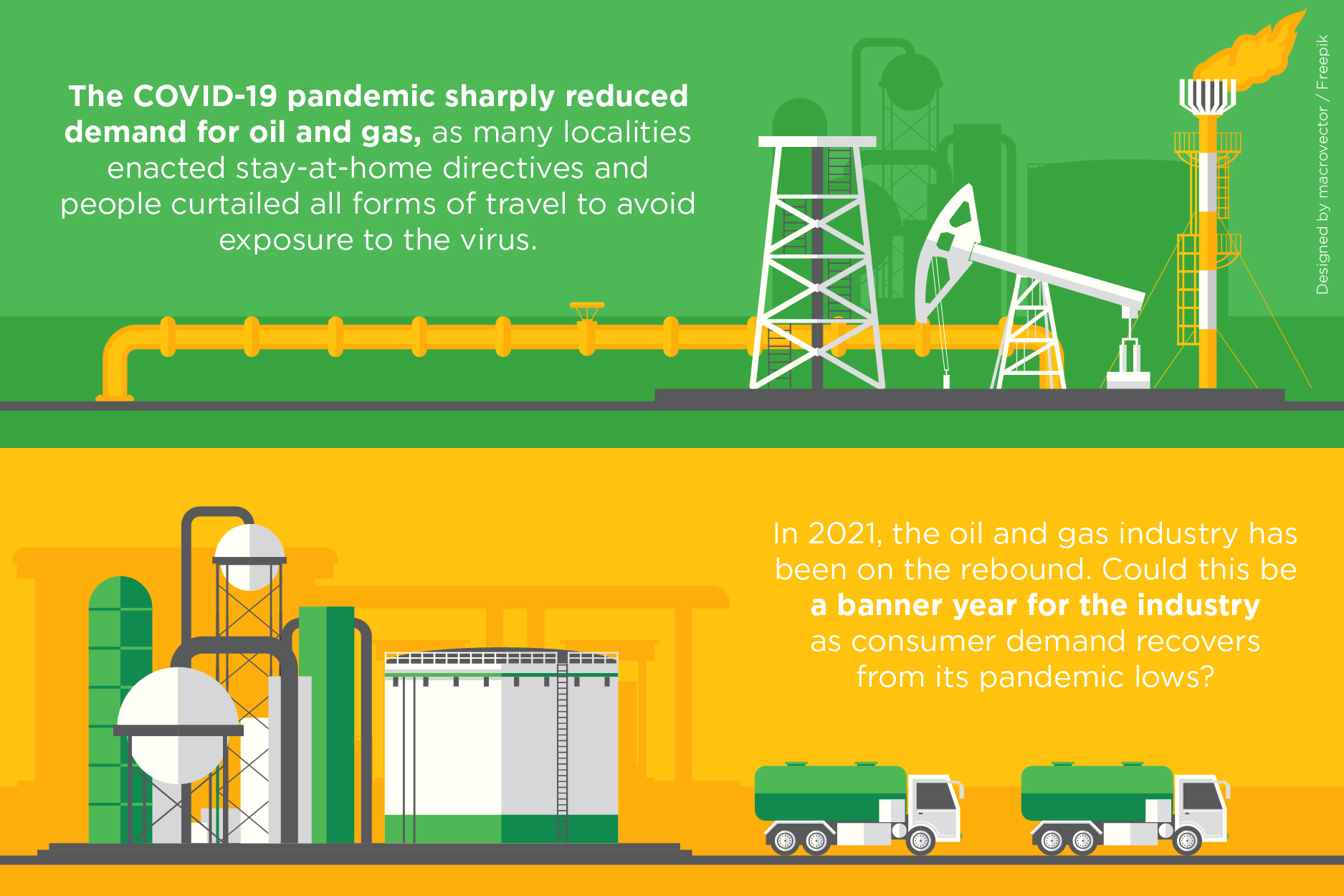In its earliest days, the COVID-19 pandemic sharply reduced demand for oil and gas, as many localities enacted stay-at-home directives and people curtailed all forms of travel to avoid exposure to the virus. Data from Apple Maps revealed that driving activity in March 2020 dropped by almost 50% compared to the Jan. 13, 2020 baseline, before recovering that summer. Stock prices for energy companies were also depressed for much of 2020.
In 2021 so far, though, the oil and gas industry has been on the rebound. The exchange-traded fund XOP, which includes oil and gas stocks, had gained 40% on the year through February 24, 2021. Meanwhile, clean energy stocks like Tesla, one of the biggest winners of 2020, tumbled, per Axios. Could 2021 be a banner year for the industry as consumer demand recovers from its pandemic lows?
Possibly. Although, there are some big challenges ahead. Let’s take a closer look at the sector’s major trends.
1. An expected recovery in oil demand, especially in the second half of 2021
S&P Global Platts Analytics estimated that COVID-19 diminished oil demand by over 8 million barrels per day. At least 6 million of those barrels could be regained in 2021, putting demand just below the all-time highs it reached in 2019. That would mean consumption of approximately 100 million barrels by the second half of 2021.
COVID-19 vaccination campaigns should allow many areas to get back to something approaching the pre-pandemic “normal,” which means more traveling and other activities dependent upon oil and gas. Pent-up demand for holiday travel as well as the resumption of in-office work and commuting could drive gasoline prices up.
Meanwhile, airlines will be a key industry to watch. Three-fourths of the 2020 drop in oil demand was from the diminished need for kerosene as an aviation fuel. The eventual end of border closures and lockdowns could send airline demand, and the need for kerosene, soaring.

2. Possible winterization of oil and gas infrastructure in Texas
Unexpectedly cold weather throughout Texas in early 2021 put enormous pressure on the state’s self-contained power grid. Despite a widespread focus on issues with wind turbines, the major issue in this crisis was actually the breakdown of natural gas infrastructure, which supplies the majority of the Lone Star State’s power.
Low temperatures caused many natural gas pipelines to freeze, depriving power plants of the fuel they needed to supply energy to homes and other buildings. Responding to the outages in late February 2021, Texas governor Greg Abbott called for winterization of power infrastructure to ensure better reliability in the future.
Whether such an initiative proceeds, and how, remains to be seen. Retrofitting of existing plants could be costly, though new winterized infrastructure would likely have a lower price tag. Natural gas transmission lines would likely be the starting point of any winterization project. Overall, shoring up the reliability of oil and gas pipelines in Texas has consequences far beyond the state’s boundaries, as Texas remains the capital of the U.S. oil and gas industry.
3. Digital transformation marches on
Despite the huge fluctuations in oil and gas prices plus other disruptions in recent years, digital transformation continues apace. The industry continues to search for talent with expertise in areas like artificial intelligence (AI) to help modernize its operations.
We should expect to see renewed focus on digital transformation in 2021 if and when the COVID-19 pandemic recedes. Some specific projects that could be in the spotlight include:
- AI for accelerated data clean-up and analysis.
- Digital workforce management to dynamically assign engineers to tasks.
- “Smart” trucks with GPS and sensors for tracking their activities.
- SCADA systems that can proactively detect leaks and other issues.
- Alerting systems that send notifications directly to mobile devices.

Inspirage is committed to helping organizations in oil and gas modernize their supply chains for better efficiency and reliability. For example, we guided an aftermarket supplier of solutions for oil rigs through an upgrade of its original Demantra demand management tool. The result was much more accurate forecasting as well as easier regulatory compliance. Be sure to read the full report on this customer’s supply chain transformation.